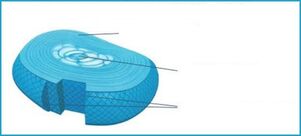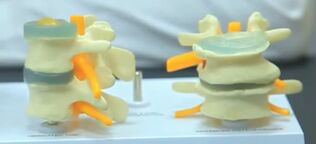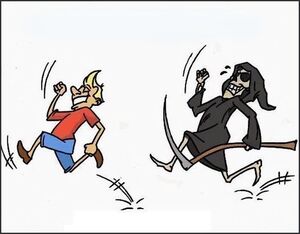Osteochondrosis of the spine - symptoms and treatment, causes, everything has been said, rethought. That it is not a disease, but the aging of the body, even if stronger than concrete, wears away, gives cracks. Unfortunately, this process of destruction, like old age, cannot be avoided, it just slows down. And most importantly, there are no pills, blends, powders, rejuvenating apples for osteochondrosis. It’s easier to understand, it’s a prize, from the moment we live, we walk, we make stupid moves, we sit, we sleep. He is not able to perform his duties with full force as in his youth. By the way, why do young people have chondrosis? Here’s a quick overview of 21st century disease. Define the important functions of the spine. Learn about the causes of youth and major complications over the years. We discuss the diagnosis of the disease and the methods of treatment. We clarify the basics of prevention and how we can save ourselves from rapid aging.
Important functions of the spine
We must not forget that our spine has 3 main functions.
- Pivot - holds the body vertically.
- Protector - protects the spinal cord.
- Padding - ribbons and cartilage soften the most varied movements of our body.

The spine absorbs the load in all areas, thanks to the unique vertebral discs located in the structure of the spinal column.
The term "osteochondrosis"
The term "osteochondrosis" is used only in Russia, the name has been abandoned in the West, and the term "intervertebral disc or cartilage degenerative disease, also known as" is used more. This definition reflects the essence of what happened on the disks.
Result: if osteochondrosis - degeneration (dystrophy) of the intervertebral cartilage from primary movements. The conclusion of this definition is that dystrophy is a violation of tissue nutrition and degeneration is a worse change in tissues.
Even an understanding of these words makes it clear what happens in the spine and where such a popular disease, "osteochondrosis, " comes from. Anyway, what kind of disease is this? Simple - premature aging.
Degeneration has four stages of development and develops in all three classes. Osteochondrosis occurs in
- neck;
- chest;
- lumbar.
Tissue malnutrition
Tissues are fed by the vast circulatory system. Arteries, veins, blood vessels and capillaries, as well as muscle tissue, are all actively involved in the nutritional process. Along with the blood, important nutrients get into the vertebrae, cartilage, and the muscles contract to help the blood move at the right speed.
Bloodless plates absorb water and nutrients as the vertebrae relax. And when you trace them, the same segments, on the contrary, give a surplus. Thus, it was found that during the depression of the spine, due to compression and expansion, the disks are saturated and purified by the method of osmosis. The more often osmosis occurs, the more satisfying and nourished they are.
The muscles surrounding the vertebrae in the back perform the process of movement. It is not hard to imagine if the muscles around the spine are not very mobile, blood circulation is slow and overall metabolism deteriorates. Cartilage suffers from a lack of nutrition and cannot be flexible and strong, so very dystrophy of the spine develops.
In the early stages of dystrophy, the incorporation of regular sports exercise into life can still be corrected fairly quickly. The younger generation hopes for a full recovery.
What happens next? When immobile for a long time, the muscles weaken, the ligaments elongate and atrophy to such an extent that they are unable to keep the spine in anatomical shape, various curvatures appear:
- lordosis;
- kyphosis;
- scoliosis.
Plates begin to collapse that do not receive the necessary food from the circulatory system for a long time and there is enough fluid available for full existence. That is, degeneration occurs, slow modification (destruction). The diagnosis is made - "Osteochondrosis" with all the symptoms and long-term treatment with drugs that are not very effective without exercise.
The fact is that the nucleus of cartilage, which is 80% water, where water gives elasticity, loses its elasticity in nature as it ages, and a sedentary lifestyle accelerates this process. Therefore, the strength of the disc will slow down, less water will flow, and its height will be thinner. But water and useful batteries require not only the plate, but all the parts around it:
- inak;
- muscles;
- fascia;
- bindings.
But due to old age, due to the slow blood circulation, some of the capillaries still dry out, they were not needed for decades, the process of osteochondrosis takes root. In this age, efforts are needed to get in shape.
Osteochondrosis is a complex of dystrophic disorders of cartilage and segments. Most often, the intervertebral liners are affected, but they also develop in the joints, they only have different names - arthrosis, arthritis (here, how these diseases differ), coxarthrosis, and many other pathologies.
Symptoms and Treatment of Spinal Osteochondrosis
Causes
There are external and internal causes of osteochondrosis that lead to damage.
The internal elements of- include genetics, tissue malnutrition in young, old age (mentioned above), nervous stresses that cause spasmodic muscles, and remain in this state for a long time, or perhaps forever, forming triggers.
- Externally (trauma, low and excessive physical activity).
The obvious causes of internal and external factors are indisputable, except in old age. Due to their laziness, people expect the musculoskeletal system to age from the moment they become independent. Recognizing the benefits of morning exercises, a healthy lifestyle, we at least partially consciously use all excuses, excuses not to do anything. I make no secret, I was like that myself.
Complications
Dystrophic changes in the intervertebral disc are not a big problem in themselves. Many live long periods of time without going to the doctor because they are not very worried about the complications of osteochondrosis. But for a variety of reasons, severe pain often occurs. After seeing a doctor, a person gets a lot of identified complications after the test, such as protrusion, hernia, spondylosis (osteophyte), and vertebral instability.
These complications are thought to lead to painful symptoms when compression occurs at the level of the disc at any part of the spine at the nerve endings. In addition to pain, weakness, decreased sensitivity, pelvic dysfunction, increased blood pressure, and in severe cases, paralysis may also occur.
A- A protrusion is a slight protrusion of the annulus fibrosus beyond the boundaries of the vertebral body, with cracks sometimes appearing in the annulus fibrosus layers due to the growth of the nucleus pulposus.
- The herniated disc is a relaxation of the annulus fibrosus. The cartilage has lost its elasticity and is divided into parts, and this condition is caused by overload, so a hernia appears. It can irritate the nerve root that appears at the level of the vertebrae in the spinal canal, and then localize to one area or another of the body.
- Osteophytes - changes in the vertebral bodies themselves, the height of the disc decreases so much that its marginal bone growths (called osteophytes) begin to have destructive activity relative to our health. The size of the hole through which the spinal nerve exits, i. e. , its root, decreases.
Opinions are also different about the appearance of discomfort and pain, forcing you to consult a professional. Pathologies of soft tissues (muscles, ligaments, tendons, fascia). Everything that sets our skeleton in motion and they signal a painful impulse by sending initial problems. Diagnoses are made - sciatica, myositis, myalgia, and more, all of which are said to be symptoms underlying osteochondrosis of the spine, and treatment is prescribed in the form of painkillers. And then everything repeats itself, a vicious circle.
Impairment of reproductive function begins in women older than 50-55 years. Enters the climax phase. It seems like a natural transition to what you can do here. But if you are not taking hormone replacement therapy or at least dietary supplements. Osteoporosis then develops rapidly, often confused with osteochondrosis.
Diagnosing spinal osteochondrosis
Self-diagnosis
- You can determine if you have it or not. To do this, it is enough to assess how often your back hurts. How quickly you get tired of a little physical work, stress. If there is difficulty, discomfort, sometimes pain, then changes are already taking place inside the spine. Since a healthy person does not feel such symptoms in the back, he is simply healthy. Although he is barely healthy now.
- The elasticity of the spine must be determined. Flexibility depends entirely on stretching. The better, the healthier the spine.
Polyclinic diagnostics
When a doctor is appointed, a referral for an X-ray is given to make the correct diagnosis. And then they prescribe the right treatment.

Comparative arrangement of healthy and sick segments. The layout shows what the ideal structure of the vertebral disc and segment body is by nature. The nerve endings move freely, they are not pinched, the disc has a high and large safety part, with such an intervertebral disc a person can withstand up to 800 kg.
And the model deformed by the disease can be seen next to it, the difference is significant. The disc flattens, the edges of the vertebral body grow and get a distorted appearance. This is exactly the view in the picture.
Treatment of osteochondrosis
Neglected complications unfortunately cannot always be treated conservatively, they often need to be treated immediately. But they are treated anyway, and they need to be treated in time.
Osteochondrosis at age 70 is considered the norm by age and will not be cured by doctors for years. In the case of young people, the approach is different, the necessary treatment is prescribed after the symptoms have been diagnosed.
Treatment can only be combined.
- Eliminate the pain, if any.
- Prescribe physiotherapy, reflexology, massage.
- exercise.
Physiotherapy practices are in principle the basis of treatment because they help restore normal biomechanics of the spine. This in turn leads to the unloading of the intervertebral discs. Swimming is a wonderful relief. But the hours begin, only after the symptoms of pain subside.
Prevention of spinal osteochondrosis
Nowadays, there are many sedentary sessions for 8 hours or more, and no organism can withstand that.
The spine is not only the support of our skeleton, but also of the spinal cord. The most important organ of the central nervous system. And if the disease is neglected, it can become disabled. I don’t want to scare you, but the paralysis of the limbs is very severe, I know this first hand.
The most important organ of the central nervous system. And if the disease is neglected, it can become disabled. I don’t want to scare you, but the paralysis of the limbs is very severe, I know this first hand.
Therefore, in case of spine problems, you should not delay the visit of the specialist, it is more expensive for you. More often, you need to think about a healthy lifestyle. Cycling, pool, gym, basic morning exercises and walks. An affordable set of exercises in the workplace to support your body physically and avoid wreckage in the future.
Achieving results requires habit formation, regularity and discipline are the basis of prevention. After all, you don’t need much, your body needs to be grateful, you need to pay attention to it, and it will respond in good health. And what do you think?
I hope the article was informative for you, you realized that almost everyone has osteochondrosis of the spine, only the symptoms and treatment are different. By studying your body more deeply, you can prevent disease and learn from the inside what to ask your doctor.
Don't forget to share with your friends, sign up for the update. Be sure to leave a comment.
Take care of yourself and your spine!

























